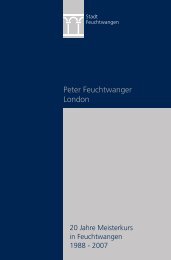Zen in the art of playing the piano - Peter Feuchtwanger
Zen in the art of playing the piano - Peter Feuchtwanger
Zen in the art of playing the piano - Peter Feuchtwanger
You also want an ePaper? Increase the reach of your titles
YUMPU automatically turns print PDFs into web optimized ePapers that Google loves.
which are <strong>in</strong> keep<strong>in</strong>g with <strong>Peter</strong> <strong>Feuchtwanger</strong>s <strong>in</strong>tentions: Its always about <strong>the</strong><br />
same th<strong>in</strong>g: that someone <strong>in</strong> <strong>the</strong> untir<strong>in</strong>g practise <strong>of</strong> his <strong>art</strong> form so completely frees<br />
himself <strong>of</strong> his fearful ego, which is worried about success and needy <strong>of</strong> material<br />
attention, that he becomes <strong>the</strong> tool <strong>of</strong> a deeper power. From this deeper power a<br />
perfect performance arises without his help and completely without <strong>in</strong>tention, like a<br />
ripe fruit fall<strong>in</strong>g from a tree. 34<br />
The Piano Exercises<br />
In <strong>Peter</strong> <strong>Feuchtwanger</strong>s Piano Exercises we have <strong>in</strong> concentrated form his teach<strong>in</strong>gs<br />
on pianistic movements, which are based on economical movements and lead to a<br />
virtuoso <strong>piano</strong> technique. With <strong>the</strong>se exercises <strong>Peter</strong> <strong>Feuchtwanger</strong> has produced a<br />
substantial contribution towards a foundation technique for <strong>the</strong> <strong>piano</strong>. They assist a<br />
bodily Reason<strong>in</strong>g(Friedrich Nietsche) with <strong>the</strong>ir axioms <strong>of</strong> movement 35 , and are,<br />
as <strong>the</strong> body <strong>the</strong>rapist Moshe Feldenkrais puts it, an education <strong>in</strong> spontaneity. In<br />
<strong>the</strong>ir essence <strong>the</strong> exercises conta<strong>in</strong> a body <strong>of</strong> wisdom which tra<strong>in</strong>s <strong>the</strong> unity <strong>of</strong> m<strong>in</strong>d,<br />
will and body. <strong>Peter</strong> <strong>Feuchtwanger</strong>s holistic methodological th<strong>in</strong>k<strong>in</strong>g is dist<strong>in</strong>guished<br />
by its uniformity, simplicity and comprehensiveness. His exercises are based on a<br />
uniform, physiologically well-founded, concept, which arises from personal<br />
experience. They are not a thought up product pieced toge<strong>the</strong>r from bits <strong>of</strong> various<br />
o<strong>the</strong>r <strong>the</strong>ories. The exercises are built up logically, one after <strong>the</strong> o<strong>the</strong>r, and always<br />
relat<strong>in</strong>g to a simple knowledge <strong>of</strong> how <strong>the</strong> body works. Therefore one doesnt have to<br />
first learn isolated, <strong>art</strong>ificial movements and <strong>the</strong>n put <strong>the</strong>m toge<strong>the</strong>r later. For: Malcoord<strong>in</strong>ated<br />
gestures are fundamentally complex, coord<strong>in</strong>ated gestures are<br />
fundamentally simple. 36 Frédéric Chop<strong>in</strong> once said about Liszt after hear<strong>in</strong>g a<br />
concert by him:La dernière chose, cest la simplicité. 37<br />
<strong>Peter</strong> <strong>Feuchtwanger</strong> says about his exercises:The exercises look very easy, but<br />
<strong>the</strong>y arent. Ive never met anyone who could do <strong>the</strong>m correctly at <strong>the</strong> first attempt.<br />
However, once someone has learnt <strong>the</strong>m, he cant understand why he couldnt<br />
manage to do <strong>the</strong>m straight away. 38 Moz<strong>art</strong> once praised <strong>the</strong> ease with which a<br />
contemporary viol<strong>in</strong>ist mastered <strong>the</strong> most difficult passages, and said one cant see<br />
that it is difficult, and one believes one must be able to do <strong>the</strong> same straight away.<br />
And that is <strong>the</strong> way it should be! 39<br />
Raymond Thiberge po<strong>in</strong>ts out that <strong>the</strong> superiority <strong>of</strong> virtuosos doesnt so much come<br />
from <strong>the</strong>ir extraord<strong>in</strong>ary abilities, than from <strong>the</strong> extremely simple and natural means<br />
which <strong>the</strong>y have discovered <strong>of</strong> us<strong>in</strong>g <strong>the</strong>m. 40 Hence he comes to <strong>the</strong> pedagogical<br />
conclusion that <strong>the</strong> acquisition <strong>of</strong> an advanced technique requires a constant<br />
simplify<strong>in</strong>g realised through <strong>the</strong> choice <strong>of</strong> <strong>the</strong> most simple and subtle action, <strong>the</strong><br />
fur<strong>the</strong>st removed from that k<strong>in</strong>d <strong>of</strong> struggle with <strong>the</strong> keyboard which is <strong>the</strong> negation <strong>of</strong><br />
all <strong>art</strong>istic achievement. 41<br />
34 Dürckheim 1961<br />
35 E.Roth<br />
36 Taylor 1996, p.39<br />
37 Cited <strong>in</strong> E.Roth, Pianistische K<strong>in</strong>äs<strong>the</strong>tik, unpublished typescript, p.7, which means, The ultimate<br />
goal is simplicity<br />
38 <strong>Peter</strong> <strong>Feuchtwanger</strong> <strong>in</strong> conversation.<br />
39 Rampe 1995, p.90<br />
40 Cited <strong>in</strong> Taylor 1996, p.98<br />
41 R.Thiberge, cited <strong>in</strong> Taylor 1996, p.88



